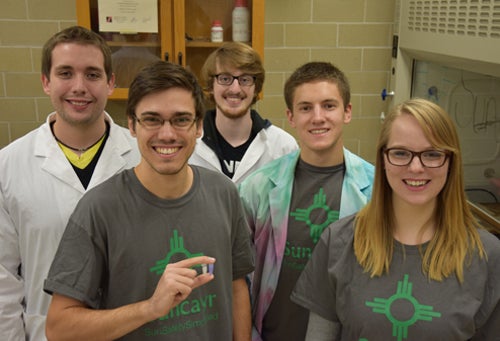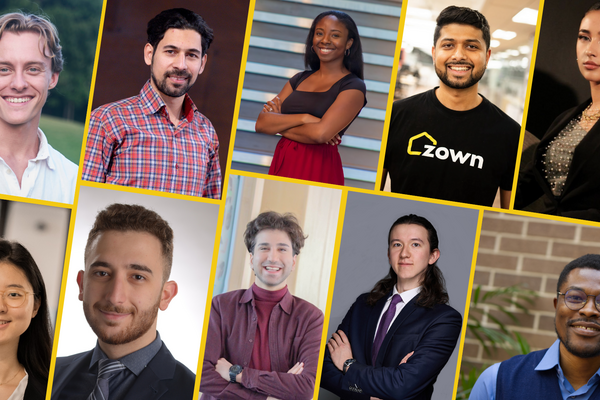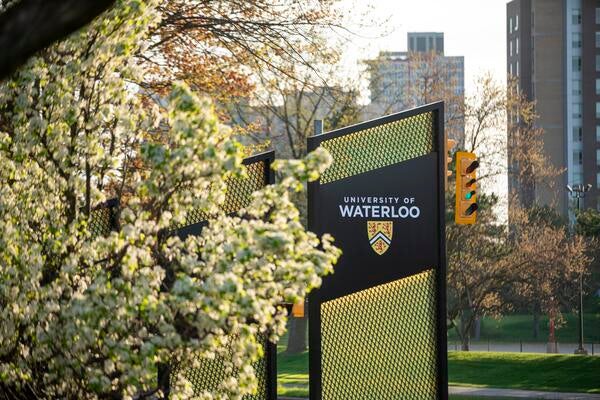
UV-responsive skin markers earn international honour for Waterloo startup
Student sun-protection startup a Dyson Award finalist

Student sun-protection startup a Dyson Award finalist
By Victoria Van Cappellen Faculty of ScienceSkin-friendly markers that use ultraviolet-responsive ink to signal when it’s time to reapply sunscreen earned University of Waterloo startup Suncayr a runner-up finish in a prestigious international design competition.
The James Dyson Award, initiated by the James Dyson Foundation in 2007, recognizes university student designers who create commercially viable products that solve practical problems, work better, and are designed with sustainability in mind. Suncayr, founded by nanotechnology engineering students in the Velocity program, competed against more than 600 entries from 18 countries to make the Top 20 before being considered a finalist.
Suncayr’s idea is simple: using the Suncayr UV marker, you first draw a design on an area of your body that frequently burns, then apply sunsreen as normal. As the sunscreen wears off, the marker’s ink turns from clear to purple indicating it’s time to reapply. The ink is not UV blocking, so it doesn’t leave a sun tattoo.
“We were brainstorming problems that we all face that nanotechnology could potentially solve,” says Derek Jouppi of Suncayr. “One thing we agreed on: We get sunburned all the time.”

Suncayr, L - R: Chad Sweeting, Andrew Martinko, Hayden Soboleski, Derek Jouppi and Rachel Pautler.
Online media also started noticing Suncayr as it advanced through the Dyson competition. A Gizmodo.com story named Suncayr as one of “7 smart new inventions that we should have had all along,” causing Suncayr’s online video to surpass 46,000 views.
As part of Velocity Science, Suncayr’s team consists of Rachel Pautler, Derek Jouppi, Andrew Martinko, Chad Sweeting and Hayden Soboleski. The members are all fourth-year students in Nanotechnology Engineering, a joint undergraduate program offered by the Faculties of Science and Engineering.
Jouppi, Suncayr's co-founder and engineer, credits the team's nanotechnology engineering education to developing a solution to solve a problem. He said connecting in third year with Nasser Abukhdeir, a Waterloo chemical engineering professor, made a major difference in the development Suncayr: "He saw our passion for entrepreneurship, and swiftly put us on the right track researching the core technology behind Suncayr.
The group was able to develop their idea through Velocity Science, a partnership between Velocity and the Faculty of Science that has helped initiate ten student-led companies since it began last April.
“We know we wouldn't have been able to make it this far without the supportive community, especially the lab space and mentorship provided by Velocity Science," says Jouppi.
As a finalist, Suncayr receives $9,000 ($7,500 USD), which they plan to use towards their final regulatory phase before rolling out their product to markets in North America.
This win isn’t the first for Suncayr. In total, Suncayr has won eight funding competitions including, Velocity’s People's Choice and Most Innovative and the Communitech’s Women in Entrepreneurship Bootcamp.
“All the pitch competitions and award applications we’ve done through Velocity Science helped us enormously when it came to applying for something larger like the Dyson Award,” says Pautler. “But the attention that came from just being an entrant has been totally crazy.”
More information about Suncayr and Velocity Science are available online.

Read more
Here are the people and events behind some of this year’s most compelling Waterloo stories

Read more
From transforming solutions for homeownership to advancing health care interventions, Waterloo talent continues to disrupt industries and drive change

Read more
The 2025 cohort represents some of the brightest new entrepreneurial minds in STEM
The University of Waterloo acknowledges that much of our work takes place on the traditional territory of the Neutral, Anishinaabeg, and Haudenosaunee peoples. Our main campus is situated on the Haldimand Tract, the land granted to the Six Nations that includes six miles on each side of the Grand River. Our active work toward reconciliation takes place across our campuses through research, learning, teaching, and community building, and is co-ordinated within the Office of Indigenous Relations.